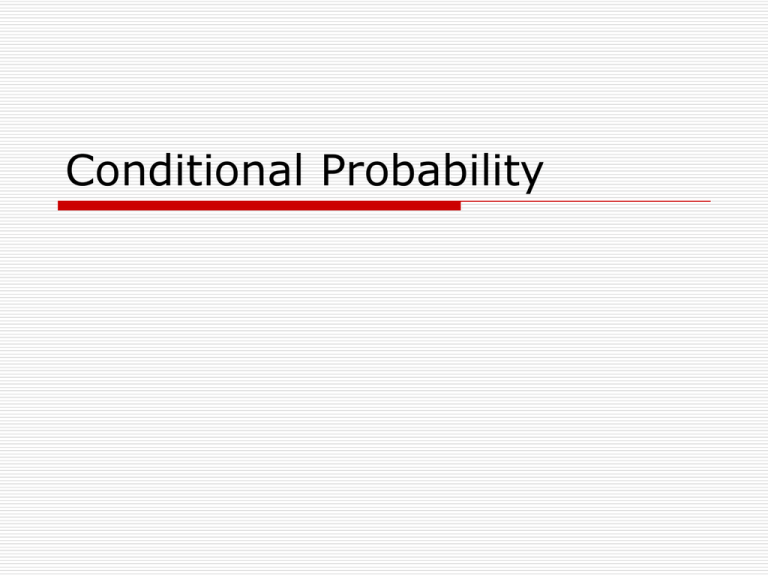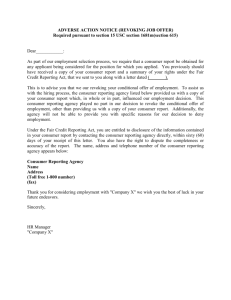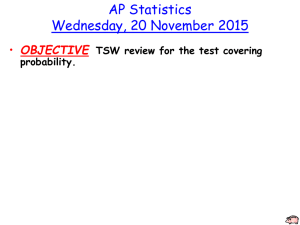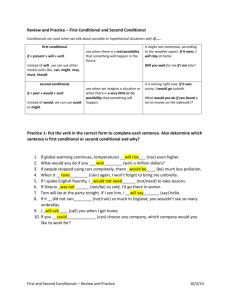Conditional Probability
advertisement

Conditional Probability Conditional Probability A newspaper editor has 120 letters from irate readers about the firing of a high school basketball coach. The letters are divided among parents and students, in support of or against the coach They have space to print only one of these letters. Conditional Probability The break down of the letters: Written by students Written by parents Total Support coach 16 44 60 Against coach 8 52 60 Total 24 96 120 What are the chances that a student letter supporting the coach will be chosen? Conditional Probability Let’s look at a Venn Diagram: Let C: event the letter is from a student Let T: event the letter favors the coach PT C C C 8 120 PC T C T 16 120 44 120 52 120 PC T P T C C Conditional Probability From the Venn Diagram: Slim chance a student letter supporting the coach will be printed: P C T 16 0.133 120 Could be unfair: student letters support the coach by a ratio of 2 : 1 PT C 0.133 2 This fact is evident since PC 0.20 3 Conditional Probability What does PT C 0.133 2 PC 0.20 3 tell us? Given the letter came from a student, the chance it supports the coach is twothirds In other words: 20% of the letters came from students. Of those, two-thirds were in favor of the coach Conditional Probability Notice previous Venn Diagram probabilities were all relative to sample space: For example: P T C 16 120 P T C P C looks at probability a letter supports a teacher based on a reduced sample 16 space, student letters only P T C 120 16 2 P C 24 24 3 120 Conditional Probability What does this mean? Knowing some info beforehand can change a probability Ex: Probability of rolling a 12 with 2 dice is 1/36, but if you know the first die is a 4, the probability is 0. If the first die is a 6, the probability is 1/6 Determining a probability after some information is known is called conditional probability Conditional Probability This is a conditional probability Notation PE | F means the probability of E happening given that F has already occurred Definition P E F , where PF 0 P E | F P F Conditional Probability P E F The formula P E | F P F PE F PF PE | F PE F PE PF | E Note: PE | F PF | E implies: Notice the reversal of the events E and F Very Important! These are two different things. They aren’t always equal. Conditional Probability Ex: Suppose 22% of Math 115A students plan to major in accounting (A) and 67% on Math 115A students are male (M). The probability of being a male or an accounting major in Math 115A is 75%. Find P A | M and PM | A. Conditional Probability Sol: P A M P A | M PM First find P A M P A M P A PM P A M 0.22 0.67 0.75 0.14 Conditional Probability Sol: P A M P A | M P M 0.14 0.67 0.2090 Conditional Probability Sol: PM A P M | A P A 0.14 0.22 0.6364 Conditional Probability Sometimes one event has no effect on another Example: flipping a coin twice Such events are called independent events Definition: Two events E and F are independent if PE | F PE or PF | E PF Conditional Probability Implications: P E | F P E P E F P E P F P E F P E P F So, two events E and F are independent if this is true. Conditional Probability The property of independence can be extended to more than two events: PE1 E2 En PE1 PE2 PEn assuming that E1 , E2 , , En are all independent. Conditional Probabilities INDEPENDENT EVENTS AND MUTUALLY EXCLUSIVE EVENTS ARE NOT THE SAME Mutually exclusive: PE F 0 Independence: P E | F P E P E F P E P F Conditional Probability Ex: Suppose we roll toss a fair coin 4 times. Let A be the event that the first toss is heads and let B be the event that there are exactly three heads. Are events A and B independent? HHHH , HHHT , HHTH , HHTT , HTHH , HTHT , HTTH , HTTT , S THHH , THHT , THTH , THTT , TTHH , TTHT , TTTH , TTTT Conditional Probability Soln: For A and B to be independent, P A B P A PB P A 168 1 2 and PB P A B 163 0.1875 HHHH , HHHT , HHTH , HHTT , HTHH , HTHT , HTTH , HTTT , S THHH , THHT , THTH , THTT , TTHH , TTHT , TTTH , TTTT 4 1 16 4 P A PB 12 14 18 0.125 Different, so dependent Conditional Probability Ex: Suppose you apply to two graduate schools: University of Arizona and Stanford University. Let A be the event that you are accepted at Arizona and S be the event of being accepted at Stanford. If P A 0.7 and PS 0.2 , and your acceptance at the schools is independent, find the probability of being accepted at either school. Conditional Probability Soln: Find P A S . P A S P A PS P A S Since A and S are independent, P A S P A PS 0.7 0.2 0.14 Conditional Probability Soln: P A S P A PS P A S 0.7 0.2 0.14 0.76 There is a 76% chance of being accepted by a graduate school. Conditional Probability Independence holds for complements as well. Ex: Using previous example, find the probability of being accepted by Arizona and not by Stanford. Conditional Probability Soln: Find P A S C . P A S C P A P S C 0.7 1 0.2 0.7 0.8 0.56 Conditional Probability Ex: Using previous example, find the probability of being accepted by exactly one school. Sol: Find probability of Arizona and not Stanford or Stanford and not Arizona. P A S C S AC Conditional Probability Sol: (continued) Since Arizona and Stanford are mutually exclusive (you can’t attend both universities) P A S C S A PA S PS A C C C P A P S C PS P AC (using independence) Conditional Probability Soln: (continued) P A PS PS PA P A S C S AC P A S C P S AC C 0.7 0.8 0.2 0.3 0.56 0.06 0.62 C Conditional Probability Independence holds across conditional probabilities as well. If E, F, and G are three events with E and F independent, then PE F | G PE | G PF | G Conditional Probability Focus on the Project: Recall: PS 0.464 and PF 0.536 However, this is for a general borrower Want to find probability of success for our borrower Conditional Probability Focus on the Project: Start by finding PS | Y and PF | Y We can find expected value of a loan work out for a borrower with 7 years of experience. Conditional Probability Focus on the Project: To find PS | Y we use the info from the DCOUNT function PS Y PS | Y PY This can be approximated by counting the number of successful 7 year records divided by total number of 7 year records Conditional Probability Focus on the Project: Technically, we have the following: PS BR YBR PS | Y PS BR | YBR PYBR So, PS | Y 105 239 0.4393 Why “technically”? Because we’re assuming that the loan workouts BR bank made were made for similar types of borrowers for the other three. So we’re extrapolating a probability from one bank and using it for all the banks. Conditional Probability Focus on the Project: Similarly, P F Y P F | Y PY This can be approximated by counting the number of failed 7 year records divided by total number of 7 year records Conditional Probability Focus on the Project: Technically, we have the following: PFBR YBR PF | Y PFBR | YBR PYBR So, PF | Y 134 239 0.5607 Conditional Probability Focus on the Project: Let Z Y be the variable giving the value of a loan work out for a borrower with 7 years experience Find EZY Conditional Probability Focus on the Project: E Z Y Success Prob. Success Failure Prob. Failure 4,000,000 0.4393 250,0000.5607 $1,897,000 This indicates that looking at only the years of experience, we should foreclose (guaranteed $2.1 million) Conditional Probability Focus on the Project: Of course, we haven’t accounted for the other two factors (education and economy) Using similar calculations, find the following: PS | T , PF | T , PS | C , and PF | C Conditional Probability Focus on the Project: 510 PS | T 1154 0.4419 644 PF | T 1154 0.5581 807 PS | C 1547 0.5217 740 PF | C 1547 0.4783 Conditional Probability Focus on the Project: Let Z T represent value of a loan work out for a borrower with a Bachelor’s Degree Let Z C represent value of a loan work out for a borrower with a loan during a Normal economy Conditional Probability Focus on the Project: Find EZT and E Z C E Z T Success Prob. Success Failure Prob. Failure 4,000,000 0.4419 250,0000.5581 $1,907,000 E Z C Success Prob. Success Failure Prob. Failure 4,000,000 0.5217 250,0000.4783 $2,206,000 Conditional Probability Focus on the Project: So, two of the three individual expected values indicates a foreclosure: EZ Y $1,897,000 EZT $1,907,000 E Z C $2,206,000 Conditional Probability Focus on the Project: Can’t use these expected values for the final decision None has all 3 characteristics combined: EZY for example has all education levels and all economic conditions included Conditional Probability Focus on the Project: Now perform some calculations to be used later PY | S , PT | S , and PC | S We will use the given bank data: That is PY | S is really PYBR | S BR and so on… Conditional Probability Focus on the Project: We can find PY T C | S PY T C | S PY | S PT | S PC | S since Y, T, and C are independent Also PY T C | F PY | F PT | F PC | F Conditional Probability Focus on the Project: PY | S PYBR | S BR number in YBR and S BR number in S BR 105 1470 0.0714 Similarly: 510 PT | S 0.5301 962 807 PC | S 0.5823 1386 Conditional Probability Focus on the Project: PY T C | S PY | S PT | S PC | S 0.0714 0.5301 0.5823 0.0220 Conditional Probability Focus on the Project: 134 PY | F 0.0753 1779 644 PT | F 0.5314 1212 740 PC | F 0.5222 1417 Conditional Probability Focus on the Project: PY T C | F PY | F PT | F PC | F 0.0753 0.5314 0.5222 0.0209 Conditional Probability Focus on the Project: Now that we have found PY T C | S and PY T C | F we will use these values to find PS | Y T C and PF | Y T C







